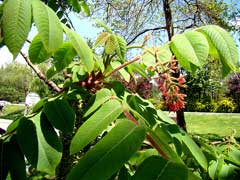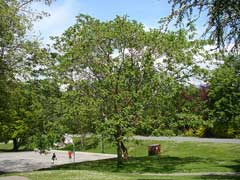 |
|
http://www.flickr.com/photos/wlcutler/3575450056/ |
 |
| http://www.flickr.com/photos/wlcutler/ |
Translate this page:
Summary
Physical Characteristics

 Juglans_ailanthifolia is a deciduous Tree growing to 20 m (65ft) by 15 m (49ft).
Juglans_ailanthifolia is a deciduous Tree growing to 20 m (65ft) by 15 m (49ft).
See above for USDA hardiness. It is hardy to UK zone 4 and is not frost tender. It is in flower in June. The species is monoecious (individual flowers are either male or female, but both sexes can be found on the same plant) and is pollinated by Wind. The plant is self-fertile.
Suitable for: light (sandy), medium (loamy) and heavy (clay) soils and prefers well-drained soil. Suitable pH: mildly acid, neutral and basic (mildly alkaline) soils. It cannot grow in the shade. It prefers moist soil.
UK Hardiness Map
US Hardiness Map
Synonyms
J. allardiana. J. correctata. J. lavellei. J. mirabunda. J. sachalinense. J. sieboldiana. non Goeppe
Plant Habitats
Edible Uses
Seed - raw, cooked or used in confectionery[22, 105, 177, 183]. A very good flavour[2]. The shell is easily cracked[117]. An edible oil is obtained from the seed, but it tends to go rancid quickly[183]. Young buds (flower?) and fruit stalks - cooked[105, 177, 183].
References More on Edible Uses
Medicinal Uses
Plants For A Future can not take any responsibility for any adverse effects from the use of plants. Always seek advice from a professional before using a plant medicinally.
The bark is anthelmintic, astringent, diuretic, lithontripic, pectoral, skin, tonic (kidneys)[178].
References More on Medicinal Uses
The Bookshop: Edible Plant Books
Our Latest books on Perennial Plants For Food Forests and Permaculture Gardens in paperback or digital formats.

Edible Tropical Plants
Food Forest Plants for Hotter Conditions: 250+ Plants For Tropical Food Forests & Permaculture Gardens.
More

Edible Temperate Plants
Plants for Your Food Forest: 500 Plants for Temperate Food Forests & Permaculture Gardens.
More

More Books
PFAF have eight books available in paperback and digital formats. Browse the shop for more information.
Shop Now
Other Uses
A brown dye is obtained from the seed husks and the bark[61]. Rich in tannin, it does not require a mordant. The bark is rich in tannin. It is used as a dye and also medicinally[178]. Plants produce chemicals which can inhibit the growth of other plants. These chemicals are dissolved out of the leaves when it rains and are washed down to the ground below, reducing the growth of plants under the tree[18, 20, 159]. The roots of many members of this genus produce substances that are toxic to many plant species, especially apples (Malus species), members of the Ericaceae, Potentilla spp and the white pines (certain Pinus spp.)[200]. Wood - soft, light, not easily cracked, of good quality. Used for cabinet making etc[46, 61]. A dynamic accumulator gathering minerals or nutrients from the soil and storing them in a more bioavailable form - used as fertilizer or to improve mulch.
Special Uses
References More on Other Uses
Cultivation details
Requires a deep well-drained loam and a sunny position sheltered from strong winds[1, 11]. Prefers a slightly alkaline soil[200]. This is the hardiest member of the genus, capable of growing in all areas of Britain[63]. It is also resistant to the attacks of most insects[160]. The young growth in spring, however, can be damaged by late frosts. This species is cultivated for its edible seed in Japan, it has the potential for producing very superior nuts, especially if hybridized with J. cinerea[117, 160]. Trees can come into bearing within 3 - 4 years from seed[63]. Plants produce a deep taproot and they are intolerant of root disturbance[1, 11]. Seedlings should be planted out into their permanent positions as soon as possible and given some protection since they are somewhat tender when young[1, 11]. Flower initiation depends upon suitable conditions in the previous summer[200]. The flowers and young growths can be destroyed by even short periods down to -2°c, but fortunately plants are usually late coming into leaf[200]. Any pruning should only be carried out in late summer to early autumn or when the plant is fully dormant otherwise wounds will bleed profusely and this will severely weaken the tree[200]. Trees have a dense canopy which tends to reduce plant growth below them. We have no specific information for this species, but the roots of several members of this genus produce substances that are toxic to many plant species, especially apples (Malus species), members of the Ericaceae, Potentilla spp and the white pines (certain Pinus spp.)[200]. The leaves of many species also secrete substances that have an inhibitory affect on plants growing underneath them. All in all this is not a very good companion plant[K]. The plant is heat tolerant in zones 8 through 5. (Plant Hardiness Zones show how well plants withstand cold winter temperatures.
Plant Heat Zones show when plants would start suffering from the heat.
The Plant Heat Zone map is based on the number of "heat days" experienced in a given area where the temperature climbs to over 86 degrees F (30°C).
At this temperature, many plants begin to suffer physiological damage. Heat Zones range from 1 (no heat days) to 12 (210 or more heat days).
For example Heat Zone. 11-1 indicates that the plant is heat tolerant in zones 11 through 1.) For polyculture design as well as the above-ground architecture (form - tree, shrub etc. and size shown above) information on the habit and root pattern is also useful and given here if available. The plant growth habit is a standard with a non-suckering single trunk [1-2]. In garden design, as well as the above-ground architecture of a plant, root structure considerations help in choosing plants that work together for their optimal soil requirements including nutrients and water. The root pattern is branching: a heart root, dividing from the crown into several primary roots going down and out [2-1].
References Carbon Farming Information and Carbon Sequestration Information
Temperature Converter
Type a value in the Celsius field to convert the value to Fahrenheit:
Fahrenheit:
The PFAF Bookshop
Plants For A Future have a number of books available in paperback and digital form. Book titles include Edible Plants, Edible Perennials, Edible Trees,Edible Shrubs, Woodland Gardening, and Temperate Food Forest Plants. Our new book is Food Forest Plants For Hotter Conditions (Tropical and Sub-Tropical).
Shop Now
Plant Propagation
The seed is best sown as soon as it is ripe in individual deep pots in a cold frame[80]. You need to protect it from mice, birds, squirrels etc. The seed usually germinates in late winter or the spring. Plant out the seedlings into their permanent positions in early summer and give some protection from the cold for their first winter or two. The seed can also be stored in cool moist conditions (such s the salad compartment of a fridge) over the winter and sown in early spring but it may then require a period of cold stratification before it will germinate[78, 80].
Other Names
If available other names are mentioned here
Heartnut
Native Range
TEMPERATE ASIA: Japan, Sakhalin.
Weed Potential
Right plant wrong place. We are currently updating this section.
Please note that a plant may be invasive in one area but may not in your area so it’s worth checking.
Conservation Status
IUCN Red List of Threatened Plants Status :

Growth: S = slow M = medium F = fast. Soil: L = light (sandy) M = medium H = heavy (clay). pH: A = acid N = neutral B = basic (alkaline). Shade: F = full shade S = semi-shade N = no shade. Moisture: D = dry M = Moist We = wet Wa = water.
Expert comment
Author
Carrière.
Botanical References
1158200
Links / References
For a list of references used on this page please go here
Readers comment
| Add a comment |
|
If you have important information about this plant that may help other users please add a comment or link below. Only comments or links that are felt to be directly relevant to a plant will be included. If you think a comment/link or information contained on this page is inaccurate or misleading we would welcome your feedback at [email protected]. If you have questions about a plant please use the Forum on this website as we do not have the resources to answer questions ourselves.
* Please note: the comments by website users are not necessarily those held by PFAF and may give misleading or inaccurate information.
To leave a comment please Register or login here All comments need to be approved so will not appear immediately.
|
Subject : Juglans_ailanthifolia
|
|
|
|